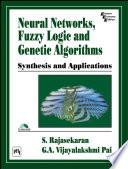
NEURAL NETWORKS, FUZZY LOGIC AND GENETIC ALGORITHM
SYNTHESIS AND APPLICATIONS (WITH CD)
This book provides comprehensive introduction to a consortium of technologies underlying soft computing, an evolving branch of computational intelligence. The constituent technologies discussed comprise neural networks, fuzzy logic, genetic algorithms, and a number of hybrid systems which include classes such as neuro-fuzzy, fuzzy-genetic, and neuro-genetic systems. The hybridization of the technologies is demonstrated on architectures such as Fuzzy-Back-propagation Networks (NN-FL), Simplified Fuzzy ARTMAP (NN-FL), and Fuzzy Associative Memories. The book also gives an exhaustive discussion of FL-GA hybridization. Every architecture has been discussed in detail through illustrative examples and applications. The algorithms have been presented in pseudo-code with a step-by-step illustration of the same in problems. The applications, demonstrative of the potential of the architectures, have been chosen from diverse disciplines of science and engineering. This book with a wealth of information that is clearly presented and illustrated by many examples and applications is designed for use as a text for courses in soft computing at both the senior undergraduate and first-year post-graduate engineering levels. It should also be of interest to researchers and technologists desirous of applying soft computing technologies to their respective fields of work.
- ISBN 13 : 8120321863
- ISBN 10 : 9788120321861
- Judul : NEURAL NETWORKS, FUZZY LOGIC AND GENETIC ALGORITHM
- Sub Judul : SYNTHESIS AND APPLICATIONS (WITH CD)
- Pengarang : S. RAJASEKARAN, G. A. VIJAYALAKSHMI PAI,
- Kategori : Computers
- Penerbit : PHI Learning Pvt. Ltd.
- Bahasa : en
- Tahun : 2003
- Halaman : 456
- Halaman : 456
- Google Book : http://books.google.co.id/books?id=bVbj9nhvHd4C&dq=intitle:logic+algorithm&hl=&source=gbs_api
-
Ketersediaan :
Algorithm. We have already seen the benefit of the middle-hidden layer in an
artificial neural network. We understand that the hidden layer allows ANN to
develop its own internal representation of this mapping. Such a rich and complex
internal representation capability allows the hierarchical network to learn any
mapping and not just linearly separable ones. Let us consider the three-layer
network with input layer having 'l' nodes, hidden layer having 'm' nodes, and an
output layer ...
